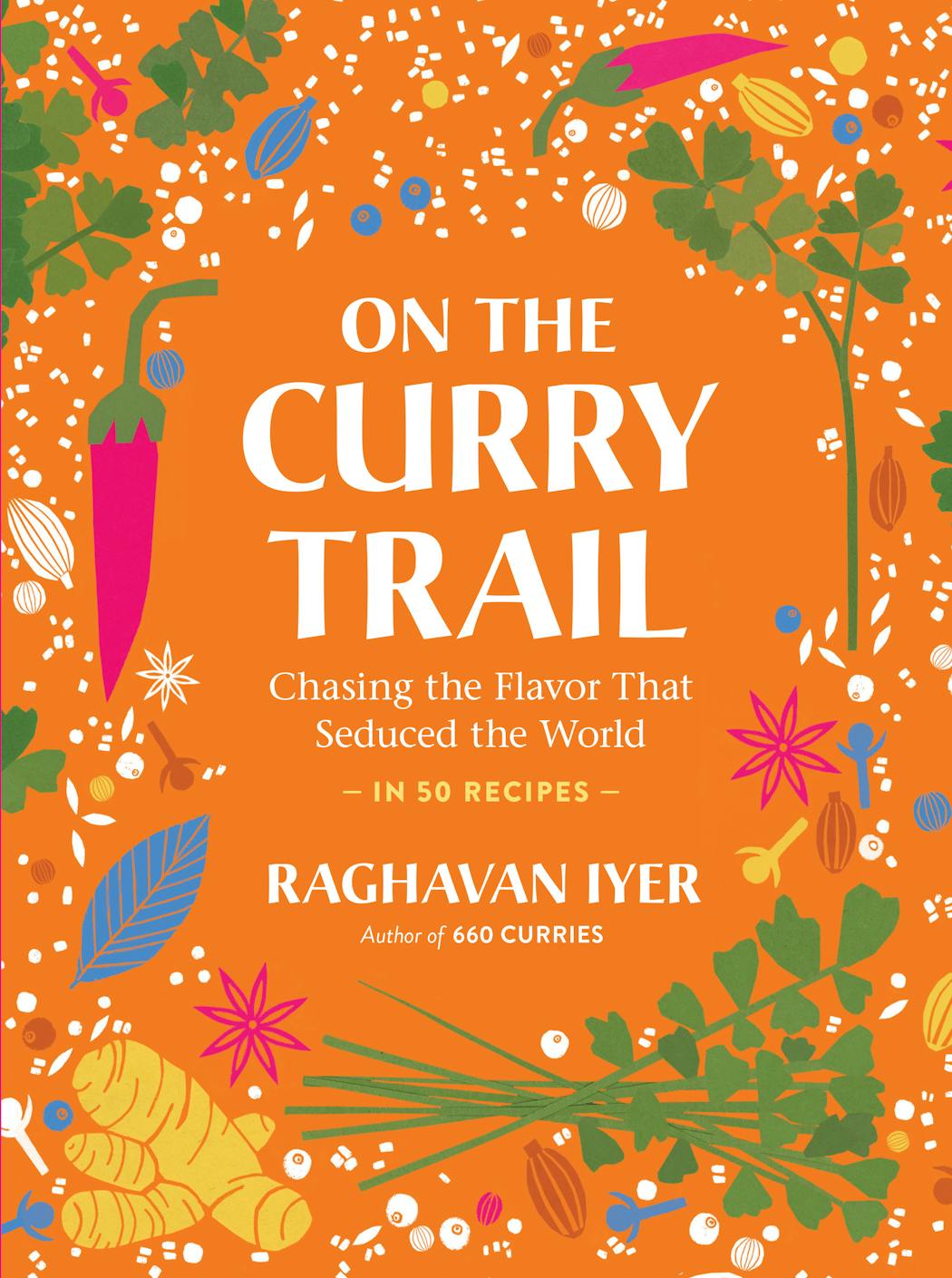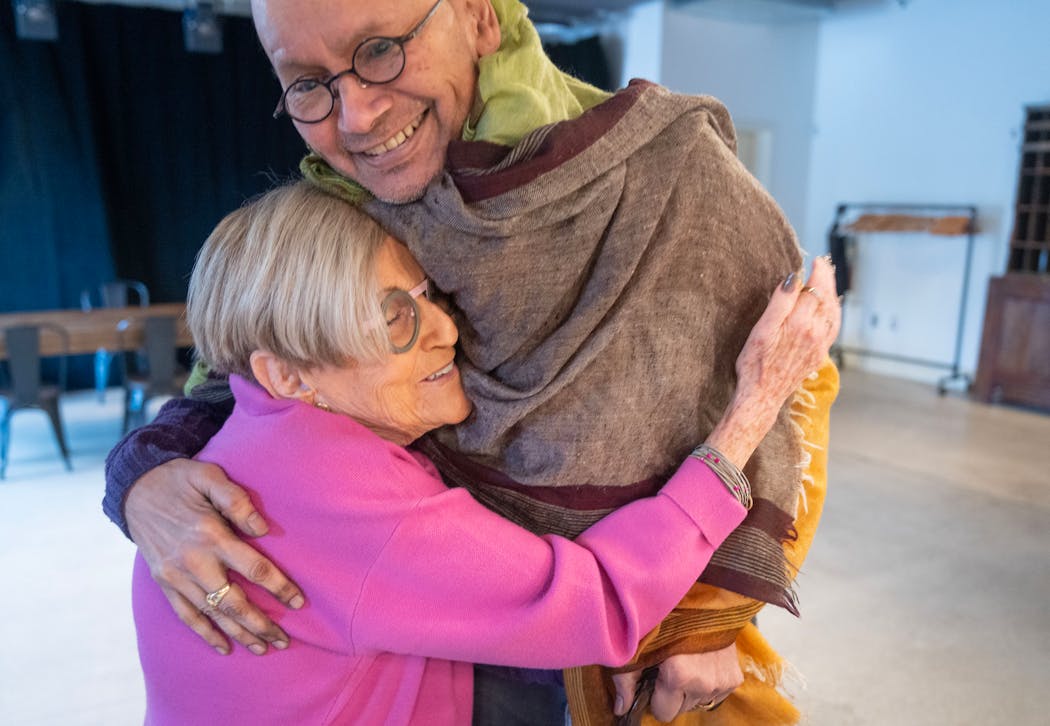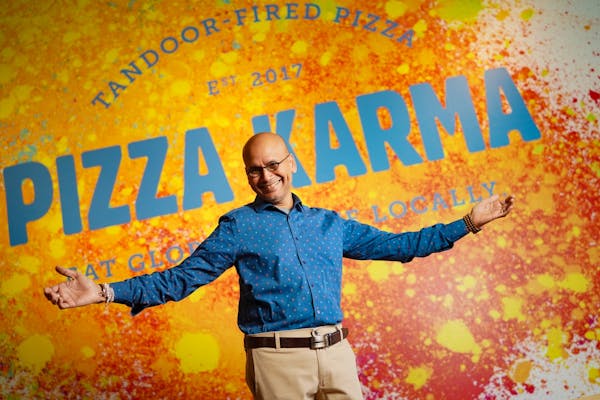Raghavan Iyer looms large in Minnesota's culinary landscape. Over the years he's introduced us to the warm and wonderful flavors of India through his cookbooks, spice blends, cooking classes and restaurants.
His latest book, "On the Curry Trail: Chasing the Flavor That Seduced the World," traces the complex history of India's spices and their effect on world cuisines.
It will be his last book. After landing the contract, Iyer was diagnosed with Stage 4 colorectal cancer. He has been living with the disease for five years, longer than most, but as the cancer has spread to his brain and lungs, Iyer has publicly acknowledged that this will be his final chapter.
"This book is not an homage to my death," he recently told the New York Times. "This is really celebrating life, family, friends and food."
An innate teacher and animated host, Iyer approaches the book with warmth and expertise as he invites cooks to build their own spice mixture — toasting and grinding whole spices for what he calls the Mother Blend — before plunging into the fascinating history of curry as it crisscrosses the globe.
"I wanted to do a companion story to the '660 Curries,' " Iyer said in a recent interview about his 2008 groundbreaking cookbook. "I thought what better way to look at curries than through the lens of the Indian diaspora? It was propelled primarily through colonialism, with Indians as indentured servants and slaves."
"On the Curry Trail" includes a breathtaking amount of research on both world history and the Indians who resettled throughout the world, whether by force or choice. Much of that research was done by former Minnesota Public Radio archivist Margaret Bresnahan, who Iyer said did "a brilliant job" of capturing and distilling 6,000 years of trading history.
"It's such rich information," he said. "It really was quite important to have that. I could sift through it and start answering some of my own questions."
What unfurls are recipes for Ethiopian red lentils with ginger, handheld eggplant pies from Israel, and even a Trinidad and Tobago spice blend that has a Minnesota connection, via Harry Singh's Original Caribbean Restaurant and the much-missed Marla's Caribbean Cuisine.
Changing times
As the spices wove their way into different cultures and new dishes throughout the world — even here in modern middle America — the approach to spice began to evolve.
"The landscape is changing, which I think is great," he said. "This has been a land of salt and white pepper. Now we're infusing some colors and spice. It's almost like a great backdrop — like an artist throwing a can of paint onto a canvas. Spices do the same thing."
It's a change whose time has come, he said.
"I'm so tired of seeing 'Indian food' or things labeled 'Asian.' Nobody says 'American food,' " he said. "How do we break it down and really see the different regions of a place, which are so unique and vibrant and different? When we're talking about regionality, that's when a cuisine has evolved."
One of the exciting ways our local food scene has evolved comes with the addition of new residents who settle here from other cultures. Immigrants are to thank for the Twin Cities' abundance of steaming bowls of pho, tacos built upon ground heirloom corn and abundant spreads or savory vegetables and stewed meats presented on circles of injera.
"The important stories come from these hidden cultures we take for granted," said Iyer. "We have each other to hang onto. Because if we don't have that, how are we going to learn from each other? It's not about one culture. It's about all the cultures mingling together. That's when we begin to address the issues of racism and the continuation of 'them against us.' "
A fresh start
Iyer, 61, was born and raised in Mumbai. After graduating with a degree in chemistry, he opened a book that listed American universities, looking for an opportunity to travel and study hospitality, and landed on Southwest State University in Marshall, Minn. (Why trade the more solitary study of chemistry for a people-focused industry like hospitality? "I guess to keep myself from getting bored," Iyer said.)
While he did find his partner of 41 years in rural Minnesota — he and Terry Erickson met on Iyer's first day in the U.S. — there wasn't much in the way of familiar flavors for Iyer, a vegetarian who couldn't cook. Typical Midwestern fare, meat-focused and timid in its use of spices (and an ill-fated attempted at potato curry), drove him to launch a familial correspondence course of sorts. Through letters from his family in India, he learned how to re-create the tastes and aromas of home: roasted mustard seeds, cumin seeds, chiles — what Iyer calls "the primal flavors that permeate."
After studying and learning Indian cuisine, he embarked on his life's mission to share that knowledge. He started in Minnesota, but his accessible and revelatory culinary lessons carried around the world.
"Food, we can all agree, is a great way to start conversation," Iyer said. "Everybody eats. Everyone sort of gets into what it is. There's no threatening factor in what can creep into an agenda. People really let their guard down."
He had already begun writing his first cookbook, one that would teach Indian cooking to a new audience — like his new Minnesota neighbors. On a plane trip to a writers getaway, he would make a serendipitous connection with another Minnesota cookbook author, Lynne Rossetto Kasper.
"This young person sits down next to me and it was Raghavan," recalled Rossetto Kasper. "We started to talk. He was looking at his first book and he was looking for an agent. I had an agent — still do — and during that conference we became friends."
Over the years, the two would share several conversations on Rossetto Kasper's influential and award-winning culinary radio show, "The Splendid Table," bringing listeners along and affording Iyer another teaching platform.
"He broadened my interest in [Indian cuisine] and understanding," said Rossetto Kasper. "He's contributed so much. He's made it doable without insulting or dumbing it down."
In 2001 his first book, "Betty Crocker's Indian Home Cooking," was published. It was a landmark for the General Mills-owned brand, which until then had only published two other world cuisine cookbooks: Chinese and Italian.
Iyer recalled asking an editor, "Is Betty ready for Indian?" And after one dazzling proposal, the answer was an emphatic yes.
"When he did his first book with General Mills, that was a big deal for them," said longtime friend and food writer Sue Zelickson. "He tapped into a world that was new to everybody — everybody unless you were born in India. To him it was his own language — the language of food and spices."
His other books include the more biographic "The Turmeric Trail: Recipes and Memories From an Indian Childhood" (2002) and the seminal "660 Curries: The Gateway to Indian Cooking" (2008), a tome that further explored the rich and saucy stews and dishes in an impressive 800 pages. He has won awards from both the James Beard Foundation and the International Association of Culinary Professionals.
Iyer also has launched spice blends, consulted on frozen meals for Target's in-house brand and helped open restaurants, including the Twin Cities' Pizza Karma with its Tandoor-fired crusts. He also continues to work on his Revival Foods Project, which aims to help bring comfort food from different cultures to patients with health challenges, a direct result of his experience as a cancer patient.
Those who know Iyer come back to his kindness and constant desire to share, teach and connect with others.
"He's a born teacher," said Rossetto Kasper. "He has that wonderful gift — his enthusiasm, his kindness. He never talks down to anyone. He can share the most complex information and make it totally understandable."
Zelickson calls him a gentle giant of the culinary world: "He took his past life into his future and changed the future of Indian food for so many people."
Prawn Curry with Darkened Cinnamon
Serves 4.
Note: In "On the Curry Trail," (Workman, 2023), Raghavan Iyer categorizes the book geographically. This recipe is from southern Sri Lanka, a top exporter of cinnamon. Some tips from Iyer: "Never buy ground cinnamon, as the oils in it dissipate in aroma and flavor. You are better off grinding the whole sticks just before use." Find fresh curry leaves, which provide a mild citrusy flavor and intense aroma, at Indian grocery stores and online. Remove the leaves by sliding your fingers down the stem. And you can find Madras curry powder in supermarkets, but it's easy to make your own.
• 3 sticks cinnamon (see Note)
• 2 tsp. Madras curry powder (see recipe)
• 6 medium cloves garlic, finely chopped
• 3 slices fresh ginger (each about the size of a quarter), finely chopped
• 1 lb. large shrimp (21-25 per lb.), peeled and deveined, tails left on
• 2 tbsp. coconut or canola oil
• 1 tsp. black or yellow mustard seeds
• 1 (14-oz.) can unsweetened coconut milk
• 1/4 c. coarsely chopped fresh curry leaves (see Note)
• 2 tsp. black peppercorns, coarsely cracked
• 1 tsp. coarse sea salt
Directions
Preheat a small skillet over medium-high heat. Once the pan is hot (holding your palm close to the base, you should feel the heat within 5 seconds), break up the cinnamon sticks into smaller pieces and throw them in the skillet. Toast, stirring the pieces constantly, or shaking the skillet very often, until they darken further and smell incredibly fragrant, 1 to 2 minutes. Transfer them to a spice grinder (or clean coffee grinder), and allow the pieces to cool, about 5 minutes. Pulverize the cinnamon to the texture of finely ground black pepper.
Combine the cinnamon, curry powder, garlic and ginger in a large bowl; add the shrimp and toss to coat. Refrigerate, covered, for at least 30 minutes or as long as overnight.
Heat the oil in a large skillet over medium-high heat. Once the oil appears to shimmer, add the mustard seeds, cover, and cook until the seeds have stopped popping, about 30 seconds. Immediately add the shrimp in a single layer and sear them for about 30 seconds on each side.
Shake the coconut milk well and pour it in. Add the curry leaves, peppercorns and salt. Bring the curry to a boil and continue to cook until the shrimp curl and turn salmon in color, 3 to 5 minutes. Using a slotted spoon, transfer the shrimp to a serving platter. Keep warm.
Continue to cook the sauce, uncovered, stirring occasionally, until it has thickened, 2 to 4 minutes. Spoon the sauce over the shrimp and serve.
Madras Curry Powder
Makes 1 cup.
Note: Called the Mother Blend in Raghavan Iyer's "On the Curry Trail," you can find Madras curry powders in the spice aisles of many supermarkets worldwide. "But making your own is embarrassingly simple, time-efficient ... and frugal," writes Iyer. It's the backbone of many recipes used in the book. To get at the cardamom seeds, pry open the pods, remove the seeds and discard the skin and small vein that holds them together. You'll need 10 to 12 pods for a teaspoon of seeds.
• 2 tbsp. coriander seeds
• 1 tbsp. cumin seeds
• 2 tsp. fenugreek seeds
• 1 tsp. fennel seeds
• 1 tsp. black or yellow mustard seeds
• 1 tsp. black peppercorns
• 1/2 tsp. whole cloves
• 1 tsp. cardamom seeds (see Note)
• 8 to 10 dried red chiles (like chile de arbol), stems discarded
• 2 cinnamon sticks, broken up into smaller pieces
• 1 tbsp. ground turmeric
• 1 tsp. ground ginger
• 1/2 tsp. freshly grated nutmeg
Directions
Put all the ingredients, except the turmeric, ginger and nutmeg, in a spice grinder or a clean coffee grinder. (You may have to grind the whole spices in batches.) Grind the ingredients to the consistency of finely ground black pepper, tapping the lid to release any of the blend back into the grinder. Transfer to a medium bowl; repeat with the remaining whole spices.
Stir in the turmeric, ginger and nutmeg. Store the spice blend in an airtight glass jar in a cool, dark spot away from the sunlight. The blend will keep for up to 6 months.
Singing, ceremonies and straw hats: Olympics opening ceremony in Tahiti centers Polynesian culture

Three 101-year-old friends recall fond memories in 1940s Alexandria
Celine Dion makes musical comeback at Paris Olympics with Eiffel Tower serenade







